WARHOLSTARS 1965
1928 - 1959 - 1960 -1962 - 1963 - Jan - May 1964 - June-December 1964 - 1965 - 1966 - 1967 - 1968 -1969 - 1970 - 1974 - 1975 - 1979 - 1980s+
JANUARY 1965: ANDY WARHOL MEETS EDIE SEDGWICK.

Edie Sedgwick, Chuck Wein and Andy Warhol at a party at the Empire State Building, spring 1965 (Photo: David McCabe)
LESTER PERSKY introduced Andy Warhol to EDIE SEDGWICK although she did not become a regular at the Factory until March when she was brought there by CHUCK WEIN. (L&D219)
Edie was part of the Harvard/Cambridge group - many of whom hung out at the San Remo. Edie studied sculpture "with LILY SWANN SAARINEN, the ex-wife of architect EERO SAARINEN, and living in a small studio on Brattle Street... She used to drive around town in her Mercedes to parties, lots of them given by her own brother. The two Sedgwicks were beautiful rich kids who knew how to have a good time in Cambridge.” (POP95)
JANUARY 1965: LOU REED BECOMES A WARLOCK.
Lou ran into college friend Sterling Morrison on the D train in the New York subway. They formed a band with John Cale and Angus MacLise, calling themselves the Warlocks (occasionally calling themselves the Falling Spikes). (LR80-97/UT23)
JANUARY 1965: ANDY WARHOL FILMS DRINK.
When Warhol ran into Emile de Antonio one afternoon on the street, they went to the Russian Tea Room for a drink. Andy suggested they make a movie together and "De" held up his drink, saying, "Okay Andy, I’ll do something for you that I’m sure nobody’s ever offered to do for you and you can film it: I’ll drink an entire quart of Scotch whiskey in twenty minutes ...” They went to the Factory to film it and "De" eventually passed out in a drunken stupor. Warhol called the seventy minute film DRINK to use as a trilogy with EAT and SLEEP. When Andy showed it at the Factory, De threatened to sue him if he ever showed it publicly. (POP89/90)
to filmography
JANUARY 10, 1965: SCREENING OF THE THIRTEEN MOST BEAUTIFUL WOMEN IS COVERED BY THE NEW YORK HERALD TRIBUNE.
The screening had taken place earlier in the month at Sally Kirkland's loft. The version of the film shown was the one consisting of fourteen women. (AD290)
JANUARY 11, 1965: ANDY WARHOL'S HARLOT PREMIERES.
According to Warhol biographer, David Bourdon, the screening of Harlot at the Cafe au Go Go was the premiere although the date on the ad is January 11, 1965. (DB217)
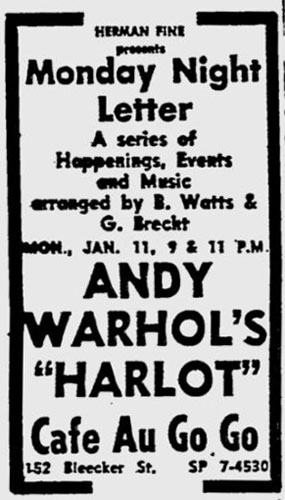
Village Voice ad, January 7, 1965, p. 10
1965: JOE DALLESANDRO HITCHHIKES TO L.A. FROM MEXICO.
Joe hitchhiked to Los Angeles with his friend, Stanley. He hung out at the bus station and ended up modeling in gay magazines.
Michael Ferguson (Joe Dallesandro, Warhol Superstar, Underground Film Icon, Actor, 2011):
"While hanging out at the bus station, a popular place to get what you want for little or nothing, Joe was approached by a man who asked him if he'd be interested in doing some modeling. It was not an uncommon scenario, though the predatory nature of such an offer may have been less contemplated by the boys who were being canvassed than their concerns about perverts and prostitution. Joe proceeded with caution, interested in the possibility of money to be made but wary of the potential dangers...
During the three months he spent in L.A. in 1965, Joe was shuffled back and forth between several photographers doing nudie shots for their muscle mail-order skin magazines." (JOEK11)
His modeling pictures made it into Physique Pictorial, but not until 1967. The first issue he appeared in was the September 1967 issue.
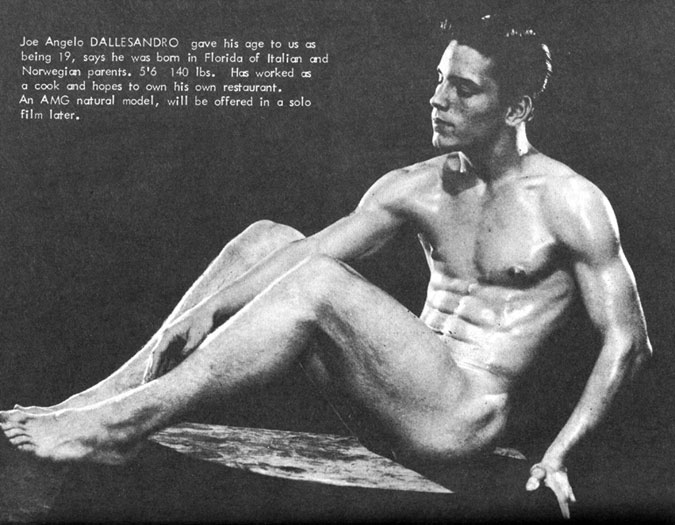
Physique Pictorial, Vol. 16 no. 3, September 1967, p. 26
The next issue his picture appeared in was in 1969. The description incorrectly notes that he "Recently he did a film for Andy Warhol called The Couch..."
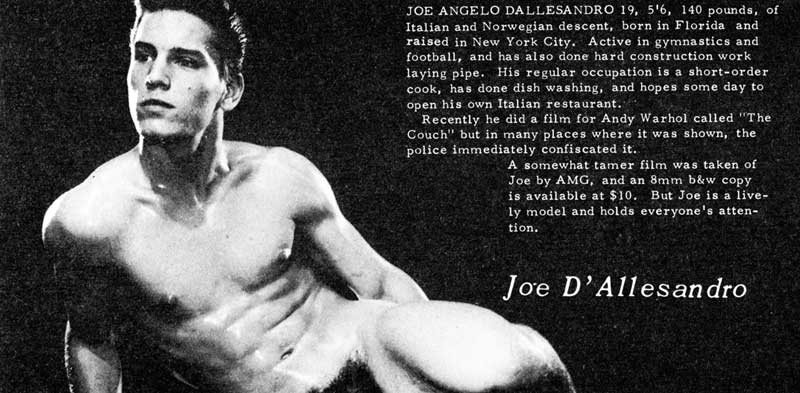
Detail from full-frontal photograph in Physique Pictorial, Volume 17, No. 2-4 comb., January 1969
This description mentions an AMG film taken of Joe. A film allegedly of Joe sometimes circulates the internet but it's unclear whether it really is Joe having sex. It begins with a fairly clear image of Joe but the actual sex scene is unclear and clumsily edited. It also doesn't fit the description of the AMG film which refers to it as "somewhat tamer" than Warhol's film, Couch.
Joe's picture was last included in the magazine in 1975. On his page, it notes that Andy Warhol "used Joe in a number of films, the latest being Frankenstein and Blood for Dracula.
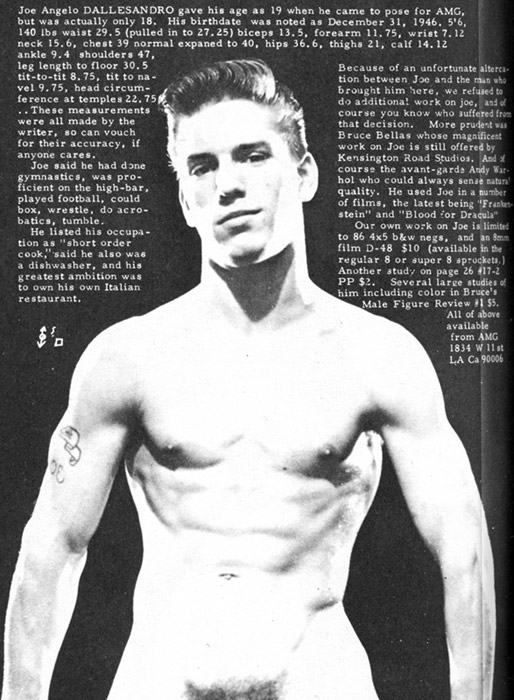
Detail from full frontal photograph in Physique Pictorial, volume 27, July 1975, p. 4
While in L.A. Joe also worked at a pizza parlor as a dishwasher. When he was arrested for assault after a fight, the court bought him a ticket to New York to return to his father. He ended up getting a “crummy little apartment” on 10th Street and hanging out with the “denizens of Times Square, experimenting with drugs,” and at one point worked at a pizza parlor in Queens. His dream was to own his own pizza parlour. (JOE20)
1965: ONDINE OPENS.
The disco Ondine (no relation to the person) opened on E. 59th Street. GERARD MALANGA picked up MARISA BERENSON there on her first modeling trip to New York and brought her to the Factory for a screen test. EDIE SEDGWICK (with her arm in a cast from her car accident ) went to Ondine often. Warhol described her dance moves - which people called "The Sedgwick" - as "sort of Egyptian, with her head and chin tilting in just the right beautiful way" whereas "everybody else was doing the jerk." (POP99)
1965: ANDY WARHOL MEETS ULTRA VIOLET.
According to Andy, he met Ultra Violet “when she walked into the Factory in a pink Chanel suit and bought a big Flowers painting that was still wet for five hundred dollars.” (POP211)
Andy Warhol on Ultra Violet (via Pat Hackett in Popism):
“She was past a certain age, but she was still beautiful; she looked a lot like Vivien Leigh... Ultra would do almost anything for publicity. She’d go on talk shows ‘representing the underground,’ and it was hilarious because she was as big a mystery to us as she was to everybody else... She’d tell journalists, ‘I collect art and love’. But what she really collected were press clippings.” (POP211)
1965: ANDY WARHOL GOES INTERNATIONAL.
Warhol had one-man exhibitions in Europe throughout the year, including Paris, Milan, Turin, Essen, Stockholm, Buenos Aires and Toronto. (BC28)
FEBRUARY 28, 1965: SIX OF ANDY WARHOL'S MOST BEAUTIFUL WOMEN BEGINS RUN IN LOBBY OF CARNEGIE HALL CINEMA.
The continuous screenings ended prematurely on March 7, 1965. (AD290)
MARCH 1965: ANDY WARHOL FILMS HORSE.
Ronald Tavel wrote the scenario for Horse. It starred Tosh, Carillo, Larry Latreille, Gregory Battcock, Daniel Cassidy, Jr, with short non-speaking appearances by Warhol, Ondine and Edie Sedgwick - her first appearance in a Warhol film.
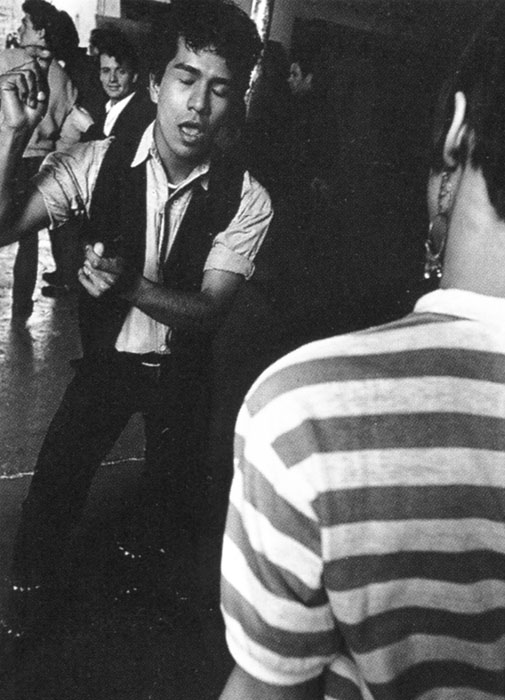
Tosh Carillo dancing with Edie Sedgwick at the Factory in 1965 (Photo: David McCabe)
to filmography
MARCH 1965: ANDY WARHOL FILMS VINYL.
EDIE SEDGWICK appeared in VINYL with an otherwise all male cast, including GERARD MALANGA, JOHN MCDERMOTT and ONDINE. 70 minutes, B&W, general concept by playwright RONALD TAVEL. (UV208) VINYL was Andy’s “interpretation of A Clockwork Orange with Gerard as a juvenile delinquent in leather saying lines like ‘Yeah, I’m a J.D. - so what.’” (POP124) Warhol had paid $3,000 for the rights to the book. (AWM51) VINYL was first shown to the public on June 4th at Jonas Mekas' Cinematheque. (L&D219)
to filmography
MARCH 19, 1965: WARHOL STARS MODEL UNDERGROUND CLOTHES IN LIFE MAGAZINE.
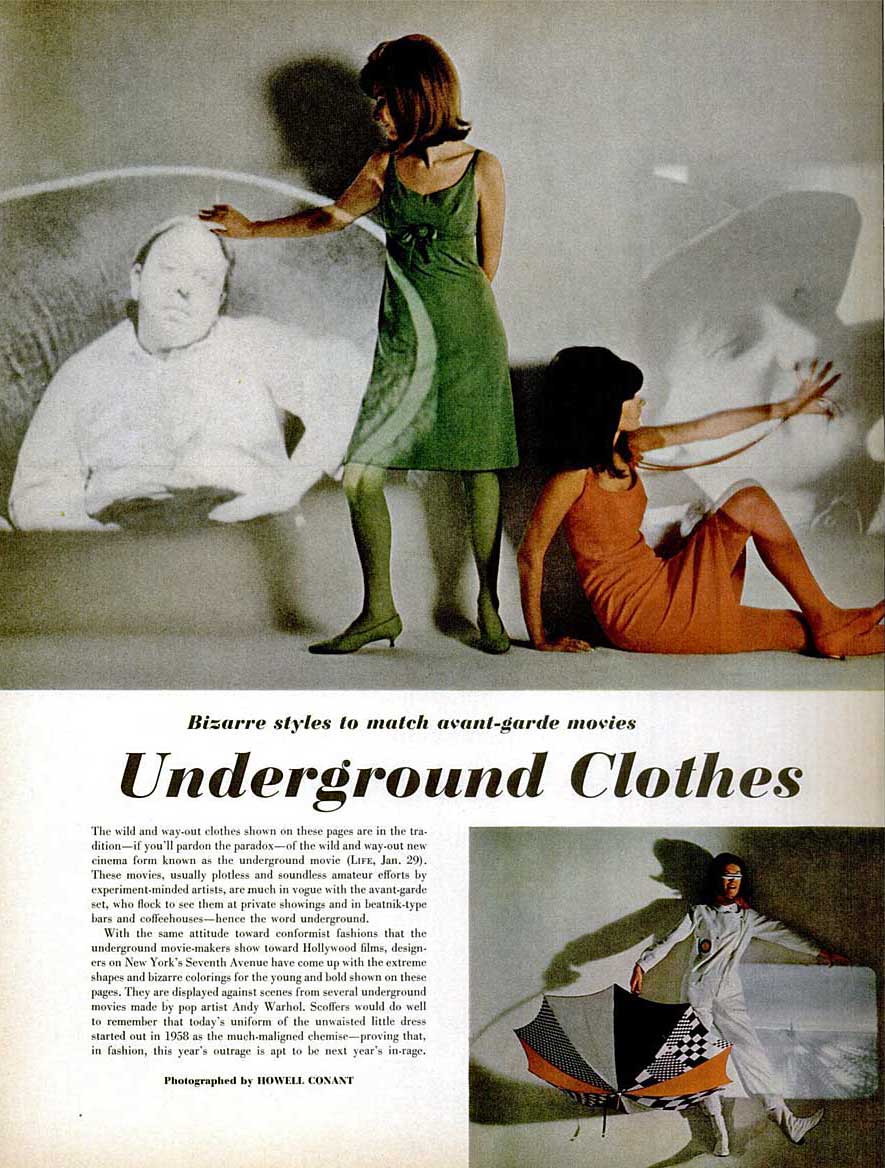
Life magazine, March 19, 1965
The article "Underground Clothes" appeared in Life magazine with photographs by Howell Conant, featuring some of Andy Warhol's superstars in a fashion spread - including the model Imu who Warhol filmed for a Screen Test and Imu and Son. The fashion editor of LIfe at the time was Sally Kirkland, Sr., the mother of Sally Kirkland whose Screen Test was included in The Thirteen Most Beautiful Women. (AD109) The models were photographed against projections of various Warhol films, including "Bat Man" (presumably Batman Dracula) and 13 Most Beautiful Girls.
The last two pages were completely devoted to Baby Jane Holzer under the heading, "Way Out Baby Jane is really in."
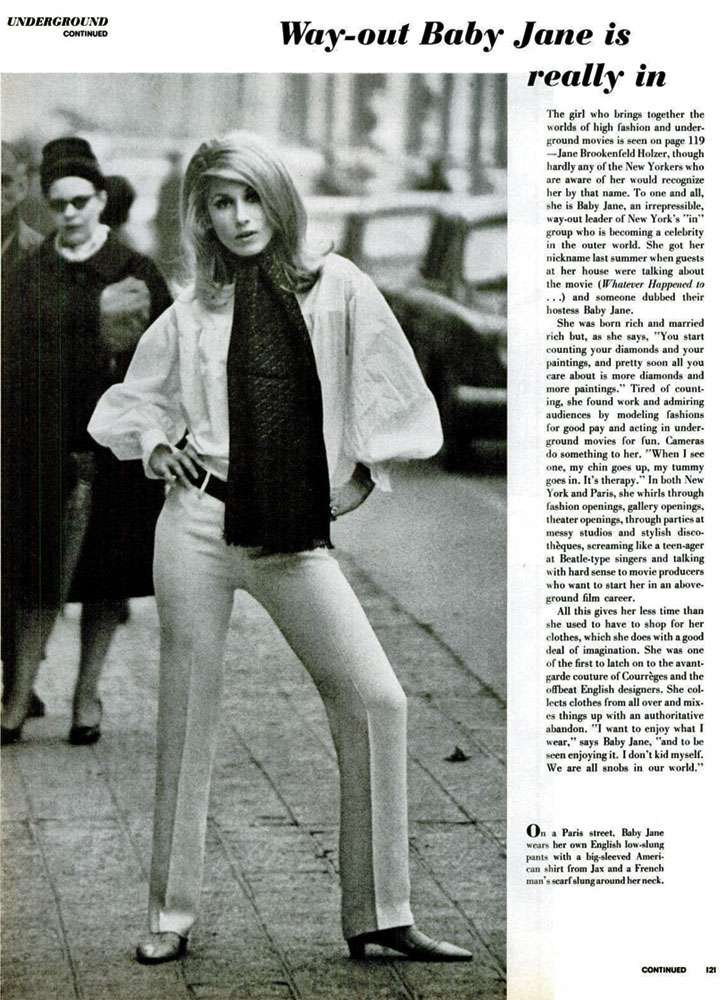
Life magazine, March 19, 1965
MARCH 19/20/21, 1965: COUCH EXCERPT IS SHOWN AT ST. MARKS CHURCH.
An excerpt from Couch featuring Gerard Malanga and Piero Heliczer was shown at the church, along with work by George Peters, Bob Cowan, and Alfred Leslie among others.
MARCH 1965: ANDY WARHOL AND HIS SUPERSTARS PARTY ATTEND A POOL PARTY AT ALROON'S HEALTH CLUB.
Photographs from the party, which include Warhol and Edie Sedgwick, were taken by Bob Adelman. His website is here. (See also the news section of this site for 26 May 2015.)
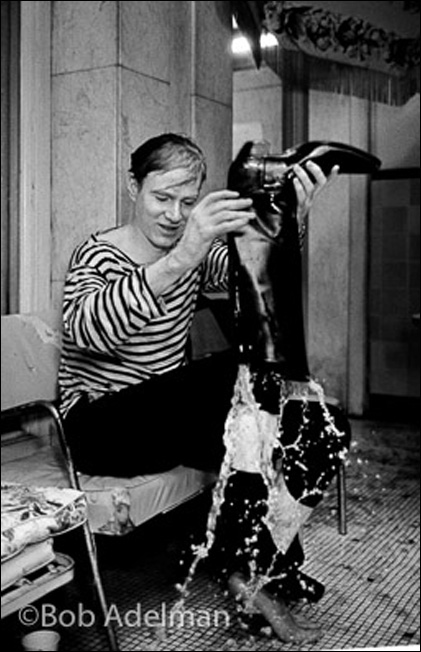
Andy Warhol after being dunked in a pool by Edie Sedgwick at a party at Al Roon's health club, NYC. 1965 (Photographer: Bob Adelman)
MARCH 22, 1965: THE LIFE OF JUANITA CASTRO OPENS.
See: The Life of Juanita Castro.
According to the writer of the film, Ronald Tavel, it was written on February 20, 1965, shot on March 13th or 14th and premiered at Jonas Mekas' Cinematheque on March 22nd. (RT)
The ad for the Cinematheque that appeared in the March 18, 1965 issue of the Village Voice did not mention a screening of the film. It noted that "March & April" would include films by Kenneth Anger, Hans Richter, and the Kuchar brothers."
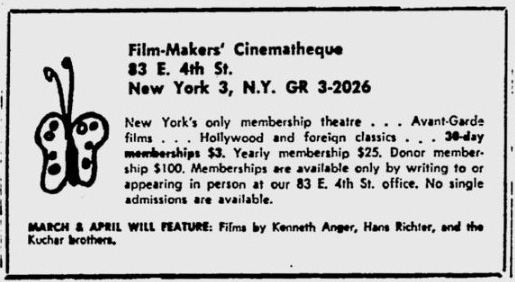
Village Voice ad, March 18, 1965
Ronald Tavel later presented The Life of Juanita Castro as a stage production. It, along with another Tavel play Shower, were the first productions of the Theatre of the Ridiculous presented at the Coda Gallery in New York over two weekends beginning July 29th. (SB223) (Shower was originally intended to be a Warhol film starring Edie Sedgwick but she refused to participate.)
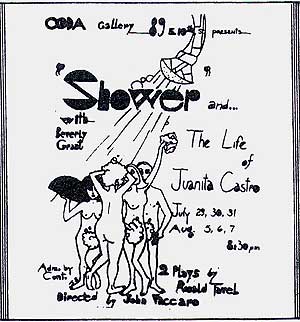
Ad for the theatrical versions of Shower and The Life of Juanita Castro at the Coda Gallery from the July 22nd issue of the Village Voice (Courtesy of Thomas Kiedrowski)
In September 1965, the two plays opened at the St. Marks Playhouse on 2nd Avenue.
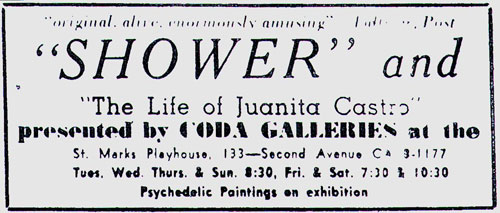
Village Voice ad for the theatrical versions of Shower and The Life of Juanita Castro at the St. Marks Playhouse (Courtesy of Thomas Kiedrowski)
The play versions of Shower and The Life of Juanita Castro were directed by John Vaccaro with a budget of twenty dollars. (SB219) Tavel had first asked Jerry Benjamin (who had co-directed Andy Warhol's film Soap Opera) to direct the plays but Benjamin was unable to do it and recommended Vaccaro. (SB219) Although Vaccaro had previously acted with the American Theater for Poets (aka the New York Poets' Theater) he had never directed before. (SB219) Vaccaro later recalled his reaction when he first read Shower and The Life Juanita Castro: "I read them and my friends read them, and they said: DON'T do these! They're HORRIBLE! And they were. Precisely why I wanted to do them." (SB219)
In 2001 Tavel also performed the play during "Warhol Week" in Moscow under the auspices of the U.S. State Department and in Berlin the same year. Diedrich Diederichen noted in Jahrbuch Theater heute 2001: Sitzen and Schauen (Friedrich Berlin Verlag, 2001), "Ronald Tavel was - and is - ahead of his time. The Life of Juanita Castro was one of the best productions of the Berlin season."
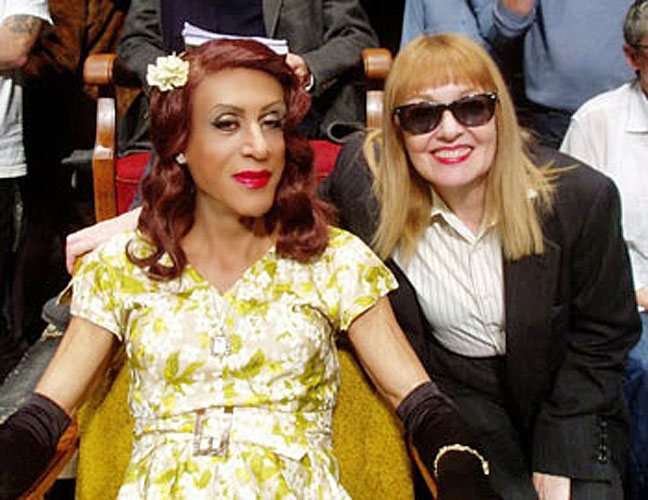
Mario Montez and Bibbe Hansen in the theatrical version of The Life of Juanita Castro at the "LIVE FILM! JACK SMITH! Five Flaming Days in a Rented World" Festival in Berlin (2009)
After Tavel's death in 2009, the play was performed as a tribute to him at the "LIVE FILM! JACK SMITH! Five Flaming Days in a Rented World" Festival in Berlin which took place October 28 - November 1, 2009. The production featured Mario Montez as Juanita Castro, Bibbe Hansen as Fidel Castro and Bruce LaBruce as Che Guevara.
APRIL 1965: LESTER PERSKY HAS A PARTY.
Lester gave a party at the Factory for The Fifty Most Beautiful People - a party which lasted until 5:00 pm the following day. JUDY GARLAND arrived from the elevator carried by five boys on their shoulders. DAVID WHITNEY danced by “in the arms of RUDOLPH NUREYEV while TENNESSEE WILLIAMS danced by in the arms of MARIE MENKEN. EDIE spent a lot of time “laughing” with BRIAN JONES. Also at the party were ALLEN GINSBERG, WILLIAM BURROUGHS and MONTGOMERY CLIFT (POP101-3) GERARD MALANGA said that “it was at ‘The Fifty Most Beautiful People’ party that the stars went out and the superstars came in, that there were more people staring at Edie than at Judy.” (POP105)
SPRING 1965: THE DREAM WEAPON IS LAUNCHED?
There is some confusion as to when "Dream Weapon" was, indeed, "launched." Sterling Morrisson gives the impression in Up-Tight, The Velvet Underground Story (Omnibus Press, 1983) that it was organized as a "ritual happening" in the Spring of 1965. He describes the event as "a mixed-media presentation to appear in the old Cinematheque." That would correspond to "Rites of the Dreamweapon II" that kicked off Jonas Mekas mixed media festival, the New Cinema Festival I. See: Expanded Cinema? (Scroll down). However, given that the title specifies "Dreamweapon II, it may mean that there was a Dreamweapon I that took place earlier, although I've not found any trace of it.
Sterling Morrison:
"Whenever I hear the word 'underground' I am reminded of when the word first acquired a specific meaning for me and for many others in NYC in the early sixties. It referred to underground cinema and the people and lifestyle that created and supported this art form. And the person who first introduced me to this scene was Piero Heliczer, a bona fide 'underground film-maker' - the first one I had ever met.
"On an early Spring day in 1965 John and I were strolling through the Eastside slums and ran into Angus [MacLise] on the corner of Essex and Delancey... It seems that Piero and Angus were organizing a 'ritual happening' at the time - a mixed-media stage presentation to appear in the old Cinematheque. Naturally, this was well before such events became all the rage. It was to be entitled Launching the Dream Weapon, and it got launched tumultuously. In the centre of the stage there was a movie screen, and between the screen and the audience a number of veils were spread out in different places. These veils were lit variously by lights and slide projectors, as Piero's films shone through them onto the screen. Dancers swirled around, and poetry and song occasionally rose up, while from behind the screen a strange music was being generated by Lou, John, Angus and me...
In the summer of 1965 we were the anonymous musicians who played at some screenings of 'underground films', and at other theatrical events, the first of which was for Piero's films (I think that Barbara Rubin showed Christmas on Earth and Kenneth Anger showed a film also). Piero taped the music, and later played it at the other screenings of his films - especially for The New Jerusalem." (UT26)
Piero had lived next door to Reed and Cale in their apartment building on Ludlow Street, but had moved to a fifth floor walk-up at 450 Grand. Angus also lived in the same building on Ludlow Street.
Musician Tony Conrad had also lived with John Cale in the apartment building on Ludlow Street:
"A lot of people went through that building on Ludlow Street. Mario Montez... lived downstairs, Angus (MacLise) was living upstairs. John (Cale) and I were there and Piero Heliczer... had the apartment next door." (UT24)
MAY 1965: THE "FIRST NEW YORK THEATER RALLY" TAKES PLACE.
Organized by Steve Paxton and Alan Solomon, the month-long festival of dance, Happenings and other performance events took place at three venues: the Judson Church, a television studio at 81st Street and Broadway and at Al Roon's Heath Club. (JD213)
Claes Oldenburg's "Washes" was performed as part of the festival - "First New York Theater Rally: Dance Concert III" - on May 22-23, 1965. (COA569)
MAY 1965: ANDY WARHOL DESCRIBES HIMSELF AS A "RETIRED ARTIST" AT THE OPENING OF FLOWERS IN PARIS.

New York Times, May 13, 1965
It was at the opening of the Flowers show at the Ileana Sonnabend Gallery (37 Quai des Grandes-Augustins, Paris) that Warhol's comment about being a retired artist was picked up by a journalist by The New York Times.
In Popism Warhol's casual comment is given the significance of an important announcement that the artist had been thinking about making for a considerable time: "I was having so much fun in Paris that I decided it was the place to make the announcement I'd been thinking about making for months: I was going to retire from painting." (POP113) The announcement has been likened to Marcel Duchamp's retirement from art during the 1920s. In reality, neither artist stopped producing work.
Billy Name (2008):
... aw did announce his 'retirement' from painting as a response to duchamp's action and he did it when he was in paris, duchampland. it may well be that andy attributed his works to brigid, and also ultra at one point, in response to the rose selavy (eros, ces't la vie) routine. the duchamp-like announcement was once known as such to insiders in the art world at one point (like henry geldzahler). (Email to Gary Comenas, August 18, 2008)
The owner of the Paris gallery, Ileana Sonnabend, was the ex-wife of Leo Castelli and had first visited Warhol on September 18, 1962, with her first consignment from the artist dated October 7, 1962. In May 1963 some of the consigned works were included in a group show at her gallery and her first solo exhibition of Warhol's work took place in January/February 1964.
According to the Andy Warhol Catalogue Raisonné, in December 1964, while Warhol's Flowers show was on at the Leo Castelli Gallery in New York, "Warhol had Flowers screens fabricated in a diminishing series, based on the dimensions of 22 by 22, 14 by 14, 8 by 8, and 5 by 5 inches. These were produced for an exhibition at Ileana Sonnabend, Paris in May 1965... although the 22-inch canvases were originally commissioned as a mural for Robert and Ethel Scull..." (RNA281)
Warhol was accompanied by Edie Sedgwick, Gerard Malanga and Chuck Wein on his trip to Paris and they spent time going to nightclubs like Castel's and Regine's Paris club - New Jimmy's. According to Warhol, they had just filmed What’s New Pussycat at Castel’s and “it seemed like the whole town was popping with stars....” (POP112)
John Ashbery reviewed the exhibition for the international edition of the New York Herald Tribune (May 17, 1965), referring to Warhol's visit as "the biggest transatlantic fuss since Oscar Wilde brought culture to Buffalo in the nineties." (AD33)
After Paris, Warhol and entourage traveled to London where they visited art dealer ROBERT FRASER, attended a poetry reading by ALLEN GINSBERG and posed for photographs by DAVID BAILEY and MICHAEL COOPER. After London they flew to Madrid, then on to Tangier which Andy thought “smelled everywhere like piss and shit, but naturally everyone thought it was great because of all the drugs.” (POP114)
JUNE 19/20, 1965: POOR LITTLE RICH GIRL PREMIERES AT ASTOR PLACE PLAYHOUSE.
POOR LITTLE RICH GIRL premiered at the Film-Makers' Cinematheque on a double bill with VINYL. The venue used by the "cinematheque" at that time was the Astor Place Playhouse. (See "Jonas Mekas and the Film-Makers' Cinematheque," here.
The Village Voice ad for the screening referred to Poor Little Rich Girl as Warhol's first "nonstatic" film. There was no mention of Edie Sedgwick. The ad also contained an announcement about an evening of films by PAUL MORRISSEY.
According to Popism, Paul started hanging out at the Factory after Gerard Malanga brought him to see VINYL. (POP181)
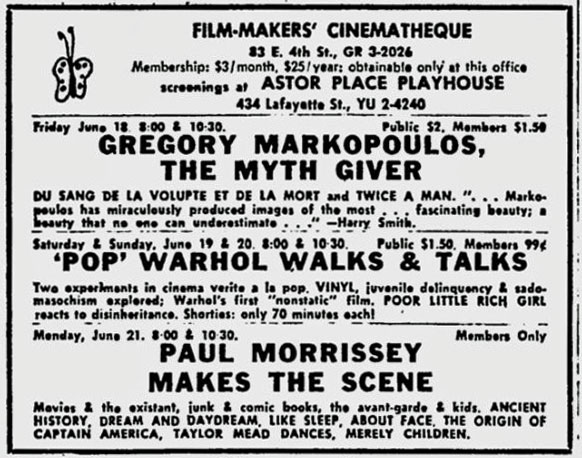
Village Voice ad, June 17, 1965, p. 15
JUNE 12, 1965: SCREEN TEST #2 OPENS.
According to Warhol biographer, David Bourdon, SCREEN TEST NO. 2, starring Mario Montez, premiered at the Film-Makers' Cinematheque at the Astor Place Playhouse. (DB217) Presumably, the "never before seen Andy Warhol work" referred to in the Village Voice ad under "An Evening with Mario Montez" was Screen Test #2.
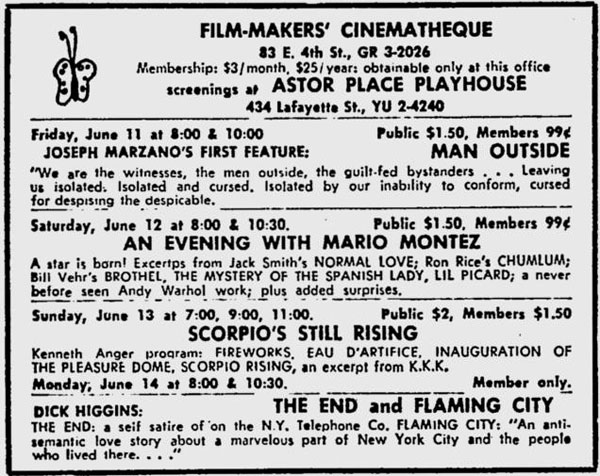
Village Voice ad, June 10, 1965, p. 15
JULY 17, 1965: BEAUTY #2 OPENS.
According to Warhol biographer, David Bourdon, BEAUTY NO. 2, starring Edie Sedgwick and Gino Piserchio, premiered at the Film-Makers' Cinematheque at the Astor Place Playhouse. (DB217) The Village Voice ad advertised "Party Sequence for The Poor Little Rich Girl and Beauty #2, both with Edie Sedgwick."
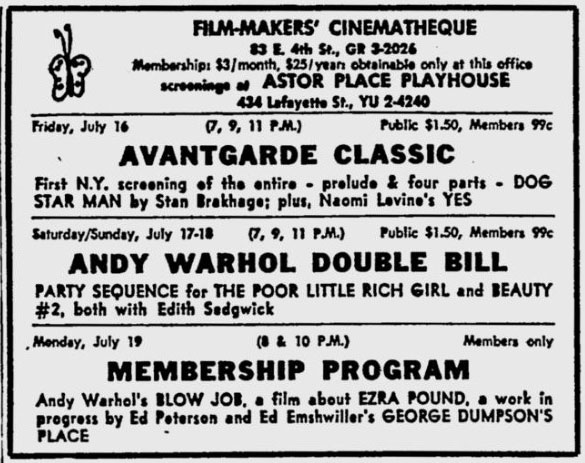
Village Voice ad, July 15, 1965, p. 10
JULY 1965: ANDY WARHOL GETS A VIDEO CAMERA.
Popism quotes Andy Warhol as describing the camera in the following way:
Andy Warhol (via Pat Hacket in Popism):
“It wasn’t portable, it just sort of sat there. It was on a long stalk and it had a head like a bug and you sat at a control panel and the camera rejointed itself like a snake and sort of angled around like a light for a drawing board ... Rotten and Birdie...wanted to steal it...” (POP)
Norelco loaned a video camera to Andy Warhol for promotional purposes. Andy used it to videotape BILLY NAME giving EDIE SEDGWICK a haircut out on the fire escape of the Factory. (POP119)
Warhol also used the video equipment for OUTER AND INNER SPACE starring Edie Sedgwick. Edie appeared smoking and talking, seated next to a television monitor on which her image also appeared. (Unfortunately the sound on Outer and Inner Space was so distorted that Edie's monologue was mostly unintelligible.)
JULY 26, 1965: THE NEW YORK TIMES PROCLAIMS EDIE SEDGWICK TO BE BABY JANE HOLZER'S SUCCESSOR.
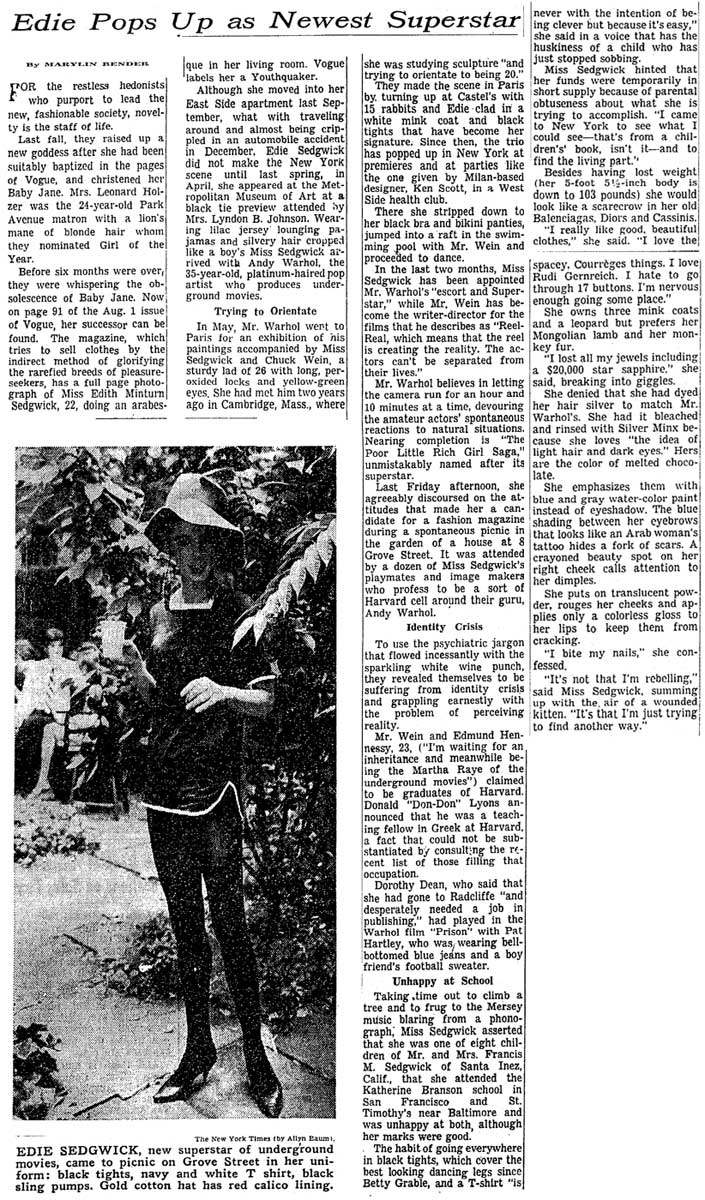
New York Times, July 26, 1965
JULY 29, 1965: RONALD TAVEL'S SHOWER AND THE LIFE OF JUANITA CASTRO OPEN AT THE CODA GALLERY.
Shower and The Life of Juanita Castro were two one-act plays by Ronald Tavel based on the scripts he had written for Warhol's films with the same names. (Shower was meant to star Edie Sedgwick but she backed out of the project.)
According to Ronald Tavel's website, "When his [Tavel's] first professional stage production, the two one-act plays, SHOWER and THE LIFE OF JUANITA CASTRO, were getting set to premiere on July 29, 1965 at the Coda Gallery on East 10th Street near Fourth Avenue in New York, Tavel felt the need for an overall title for the evening, since American audiences then tended to prefer a single experience as opposed to unrelated short pieces. He immediately decided that the name, The Theatre of The Ridiculous, would suit these one-acts and wrote a one-line manifesto for the program to justify his choice: “We have passed beyond the absurd: our position is absolutely preposterous.” Tavel had first come up with the term "ridiculous" while studying the Theatre of the Absurd in college.
See Conquest of the Ridiculous: Ronald Tavel, John Vaccaro and Charles Ludlam
AUGUST 3 - 17, 1965: THE THIRTEEN MOST BEAUTIFUL WOMEN IS SHOWN IN BUENOS AIRES.
A thirty minute version of the film was shown in the "New American Cinema" program at the Cineteca Argentina in Buenos Aires. (AD291)
AUGUST 8, 1965: ANDY WARHOL REFERS TO SUICIDE AND FRED HERKO'S DEATH IN A FEATURE FOR THE SUNDAY HERALD TRIBUNE.
From "Superpop or A Night at The Factory" by Roger Vaughan:
"While the camera is being reloaded, Warhol talks about a recent film he's done, Suicide.
'I found this person, my star, who has 13 scars on one writ st and 15 scars on the wrist from suicide attempts. He has marvelous wrists. The scars are all different shades of purple. This was my first color movie. We just focused the camera on his wrists and he pointed to each scar and told its history, like when he did it, and why, and what happened afterward.'
Someone suggests filming a real suicide, and Warhol brightens. 'Ohh, wouldn't that be something,' he says. 'One of my friends committed suicide recently, but he didn't call me.' Warhol's left hand goes to his lips in a habitual gesture. 'He was so high he didn't think, I guess. He was a dancer and had been in a couple of my films. He got high and just danced right out the window.'" (PC283)
AUGUST 28/29, 1965: HORSE and SCREEN TEST NO. 2 PLAY ASTOR PLACE.
The Astor Place Playhouse was the cinema being used by the Film-Makers' Cinematheque at the time to show underground films. (X1) The film is referred to simply as "Screen Test" in the Village Voice ad but the description fits Screen Test #2.
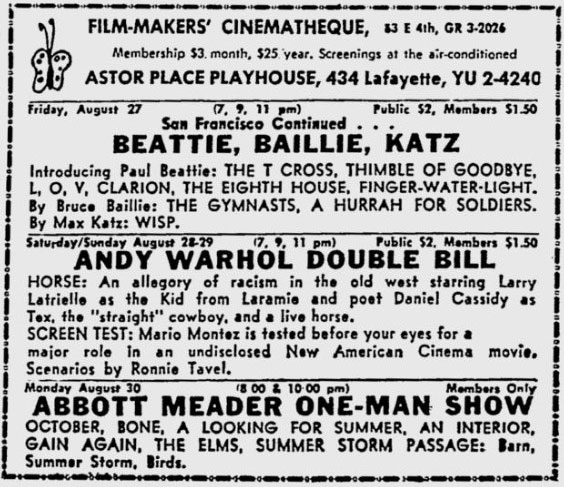
Village Voice ad, August 26, 1965
According to Warhol biographer, David Bourdon, the premiere of Horse was on November 22, 1965. (DB217)
LABOR DAY WEEKEND 1965: ANDY WARHOL FILMS MY HUSTLER.
Warhol and entourage shot MY HUSTLER on Fire Island - a film which, according to David Bourdon, cost only $500 to make. (DB265) STEPHEN SHORE, who was part of Warhol's entourage, said that the orange juice they drank one morning was secretly laced with LSD.
to filmography
The cast included Ed Hood, Paul America and Joe Campbell. Campbell is referred to as the "Sugar Plum Fairy" (slang for drug dealer). He had also been the boyfriend of San Franciscan politician Harvey Milk.
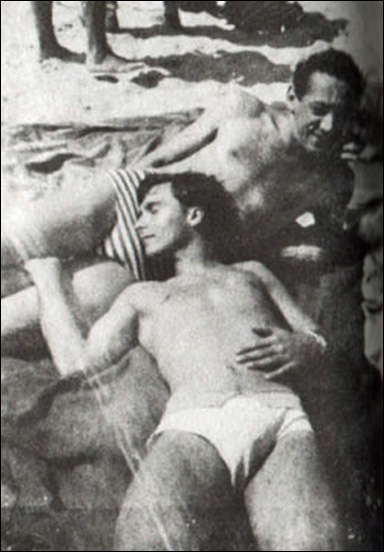
Joe Campbell (foreground) and Harvey Milk (They were together from 1956 to 1962)
AUTUMN 1965: ANDY WARHOL SHOOTS PAUL SWAN.
Swan was once known as "the most beautiful man in the world".
AUTUMN 1965: NAT FINKELSTEIN SHOOTS THE FACTORY.
Freelance photographer, NAT FINKELSTEIN, associated with the Black Star Photo Agency, went to the Factory to take pictures for a week and stayed for two years. (UT38)
SEPTEMBER 5, 1965: "EDIE SEDGWICK, SUPERSTAR"
APPEARS IN THE NEW YORK
POST.
(AF200)
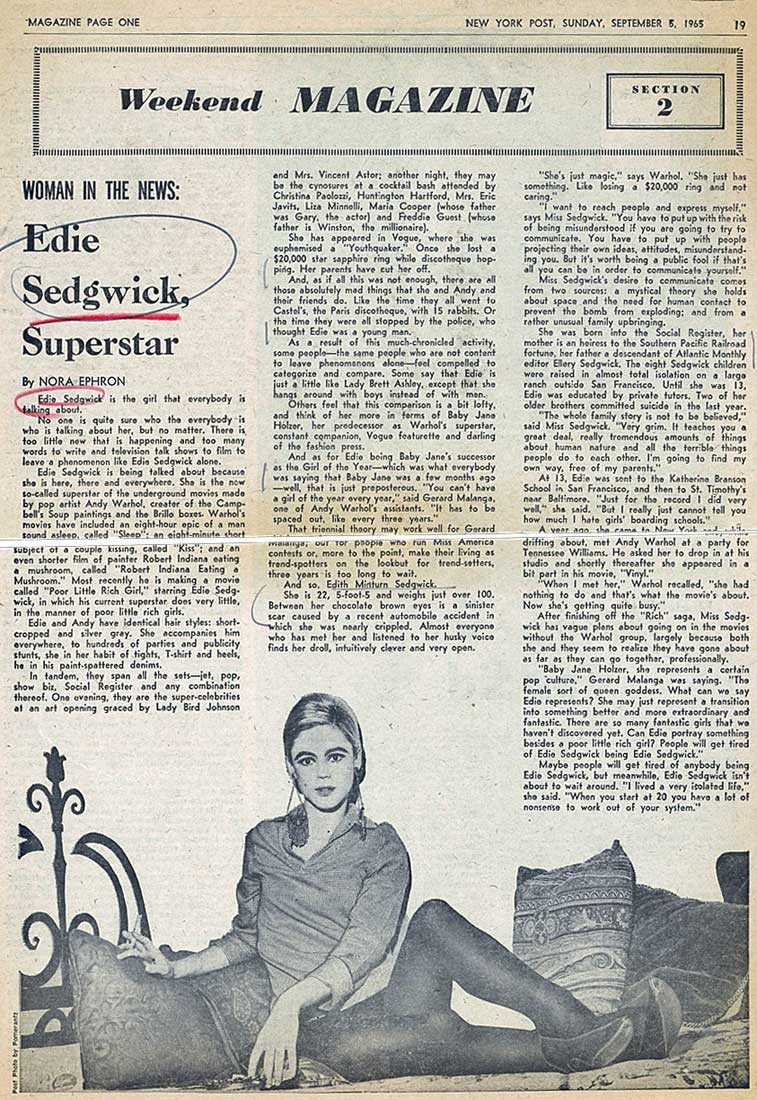
New York Post, Sunday, September 5, 1965
OCTOBER 7 - NOVEMBER 21, 1965: THE ICA EXHIBITION.
Organized by SAM GREEN, Andy Warhol had his first American museum exhibition at the Institute of Contemporary Art at the University of Pennsylvania, Philadelphia. The place was mobbed by college students. Warhol's entourage included EDIE SEDGWICK, BABY JANE HOLZER, KENNY LANE, ISABEL EBERSTADT, TAYLOR MEAD and GERARD MALANGA. SAM GREEN (who Candy Darling would later move in with) had actually taken down all the paintings before the opening because he feared that they would be damaged by the expected mob. (EDIE252)
c. NOVEMBER 1965: BABY JANE HOLZER LEAVES THE FACTORY.
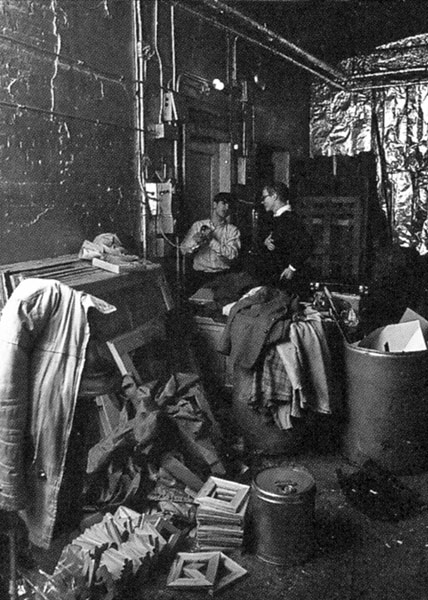
Andy Warhol at the Factory (1965) (Photo: David McCabe)
Jane Holzer left the Warhol crowd after filming her last movie, CAMP. She had become disillusioned with the amount of drug taking at the Factory and the people who were hanging out there. After leaving the Factory crowd, she continued to amass wealth by investing in real estate, later opening an ice cream shop in Palm Beach, Florida called Sweet Baby Jane's. (UW47). She also became a successful producer of plays and movies including The Kiss of the Spider Woman. (UV245) She stayed in touch with Warhol throughout the eighties and they would often attend the same social events.
NOVEMBER 26, 1965: EDIE SEDGWICK APPEARS IN LIFE MAGAZINE. (AF199)
Although a photo of Edie on the cover of that issue of Life is circulating on the internet, it is a "mock" cover. In reality, she was not on the cover although there is an article about her in the issue.
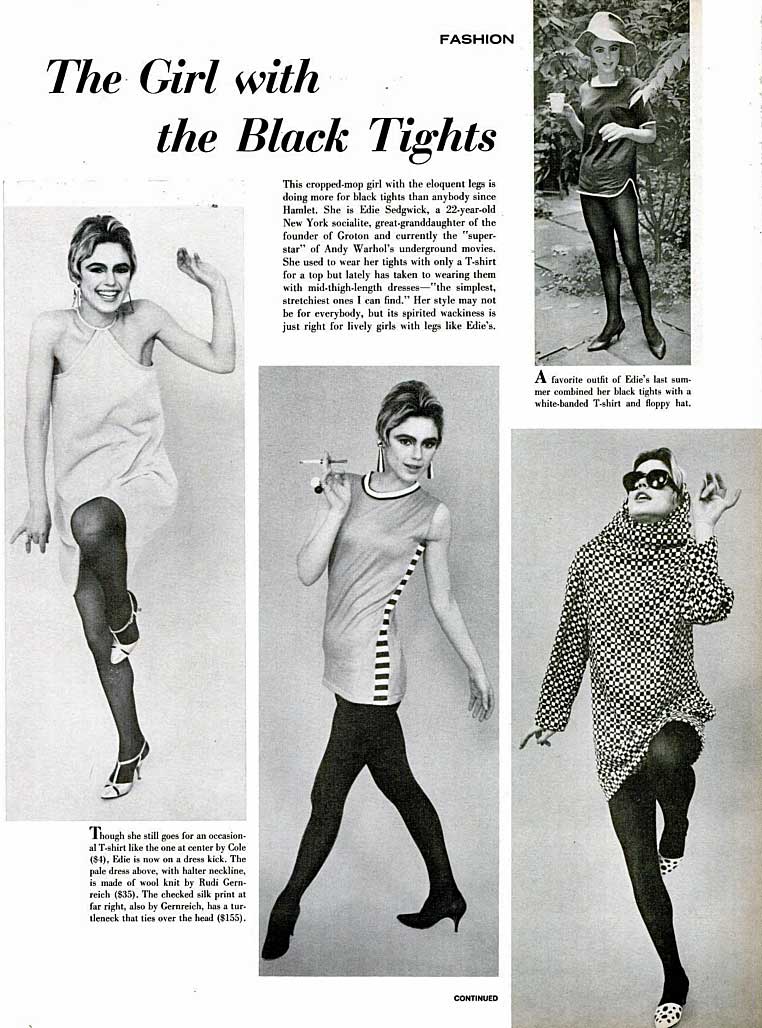
Life magazine, November 26, 1965
NOVEMBER 1965: THE VELVET UNDERGROUND IS NAMED.
LOU REED's band changed its name to the VELVET UNDERGROUND after the title of a "cheap paperback about suburban sex."
Rock journalist ALFRED G. ARONOWITZ offered to manage The Velvet Underground and they accepted. He arranged for them to open for another group he managed, Myddle Class, on December 11 at the Summit High School in Summit, New Jersey for which they were paid $75.00. This was the first time they used the name The Velvet Underground. They played after a band called 40 Fingers and before The Myddle Class. They opened with 'There She Goes Again', then played 'Venus in Furs' and ended with 'Heroin'. (UT28-29).
Angus quit the group before then, after learning that he would "have to show up at a certain time-and start playing-and then end," at a certain time which he couldn't handle. He was replaced a few days before the gig by MAUREEN (MO) TUCKER, the sister of Lou's Syracuse college friend, Jim Tucker. Jim Tucker had been Sterling Morrison's roommate at Syracuse University in a room at Sadler Hall on the floor beneath Lou Reed's own room. (LR98-9/UT19)
DECEMBER 15, 1965: THE VELVET UNDERGROUND PLAY BIZARRE.
Lou Reed (from a tape made by Nat Finkelstein at the Factory in Autumn 1966):
"We were playing together a long time ago, in a $30-a-month apartment and we really didn't have any money, and we used to eat oatmeal all day and all night and give blood... or pose for these nickel or 15 cent tabloids they have every week. And when I posed for them, my picture came out and it said I was a sex maniac killer that had killed 14 children and tape recorded it and played it in a barn in Kansas at midnight. And when John's picture came out in the paper, it said he had killed his lover because his lover was going to marry his sister, and he didn't want his sister to marry a fag.
And then we decided that since we were playing all the time anyway, why not try to get paid for it, so we ended up at a terrible coffee house working six sets a night, seven nights a week, $5 a man a night, and that lasted a week-and-a-half and we were fired, because they hated our music so much.
And then we met Andy. And we're now able to play the kind of stuff we really like to play...." (UT91-2)
The VELVET UNDERGROUND began a two week run at Cafe Bizarre, "a relatively dead club on West 3rd Street just east of Macdougal Street in the heart of Greenwich Village" - where Andy Warhol saw them perform.
The residency was arranged by their new manager Alfred Aronowitz to give The Velvet Underground some experience and "to acquire some chops". In addition to doing some of their own material, The Velvet Underground also played cover versions of songs such as 'Carol' and 'Little Queenie'. The owner of Cafe Bizarre refused to let them use drums ('too loud') so drummer Maureen Tucker played the tambourine instead.(UT29/31)
The band was fired two days after Warhol saw them. They were fed up at having been forced to work on Christmas Day "and wanted to get fired, so when the manager told them that if they played 'The Black Angel's Death Song' one more time they'd be asked to leave, they cranked out their best version ever." (UT31)
Andy Warhol was looking for a band to manage for a nightclub which he had been asked to host by impresario MICHAEL MYERBERG - who had brought Beckett's play Waiting for Godot to the USA in 1956. (LR101) Warhol had previously tried to put together a rock and roll band in 1963 with LA MONTE YOUNG and WALTER DE MARIA. (LR105)
Mary Woronov: "It was like bang! They [Velvet Underground] were with Andy and Andy was with them and they backed him absolutely. They would have walked to the end of the earth for him. And that happened in one day!" (LR113)
Myerberg's interest in the project cooled off after he saw the band performing with Warhol's films at the Cinematheque during the second week of February 1966. (UT36)
DECEMBER 1965: EDIE SEDGWICK MAKES HER LAST ANDY WARHOL FILM (SORT OF).
Edie Sedgwick's last "official" Andy Warhol film was LUPE. She had become increasingly convinced that everybody in New York was laughing at her because of her Warhol roles. After befriending Bob Dylan she was under the impression that Dylan's manager was going to offer her a contract. (POP123) (According to some references, Warhol also filmed Edie in THE ANDY WARHOL STORY in November 1966 - although the footage for this may have been lost/destroyed).
Andy filmed Lupe in Panna Grady’s apartment in the Dakota on Central Park West and 72nd Street.
Andy Warhol (via Pat Hackett in Popism):
“Panna was a hostess of the sixties who put uptown intellectuals together with Lower East Side types - she seemed to adore the drug-related writers in particular.” (POP)
Lupe was based on Lupe Velez, the “Mexican Spitfire who lived in a Mexican-style palazzo in Hollywood” and decided to commit “the most beautiful” suicide ever, “complete with an altar and burning candles. So she set it all up and then took poison and lay down to wait for this beautiful death to overtake her, but then at the last minute she started to vomit and died with her head wrapped around the toilet bowl.” (POP127)
DECEMBER 6, 1965: MICKEY RUSKIN OPENS MAX'S KANSAS CITY.
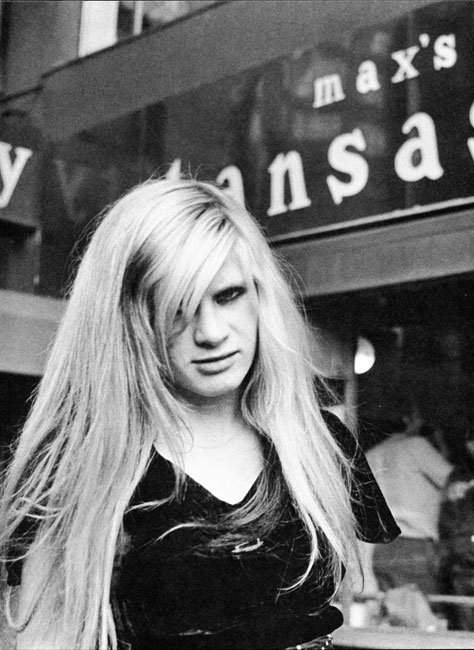
Andrea Feldman outside Max's Kansas City (Photo: Anton Perich)
Max's Kansas City opened at 213 Park Avenue South, between 17th and 18th Streets off Union Square. (HR/IAP32) The legendary bar/restaurant became a hangout for Andy Warhol and his entourage during the late 60s. It's difficult to ascertain exactly when Warhol hung out there, however, it's written in Popism that Warhol's crowd started hanging out there in about September 1966. (See 1966)
The second Factory was located near Max's and Warhol moved to the second Factory in early 1968. He was shot by Valerie Solanas in June 1968 and it is doubtful he spent much time at Max's after that. His "superstars" however, continued to hang out at the club into the 1970s. By the mid to late 70s it had become a mostly heterosexual rock and roll venue. The club closed in 1981. Ruskin's first bar was the 10th Street Coffeehouse in c. 1960. In 1962 he opened the Ninth Circle which later became a gay hustler bar. He also ran two unsuccessful ventures: The Longview and Levine's (See 1969).
LATE 1965/66: ANDY WARHOL CREATES SILVER CLOUDS.
The Andy Warhol Catalogue Raisonné lists numerous version of the Silver Clouds including the Castelli Series attributed to late 1965 - 1966; the Ferus series attributed to May 1966; the E.A.T. series attributed to October 1967; the Silver Clouds used as "decor" for for Merce Cunningham's dance piece, RainForest; attributed to 1968, and the Warhol Museum series attributed to 1994.
About the Castelli series, the cat. rais. notes that it consisted of "an undetermined number of elements" and "it is not known whether the clouds were discarded after exhibition or reused." The listed exhibitions for this series are: Leo Castelli Gallery (April 1966), the Contemporary Art Center in Cincinnati ("May 17 - [?], 1966"), the Galerie Hans in Hamburg (November 10 - 29, 1966), the Galerie Rudolf Zwirner in Cologne (January 24 - February 28, 1967) and the ICA in Boson in 1966 where twelve were exhibited.
About the Ferus series, the cat. rais. notes that they were "an undetermined number made for exhibition at Ferus" in May 1966 and that there were "one hundred examples offered for sale, packaged in plastic wrappers, with a stamped reproduction of Warhol's signature printed across the wrapper."
The E.A.T. series consisted of "twenty made for Experiments in Art and Technology (E.A.T.) Press Conference" on October 10, 1967. The RainForest clouds consisted of "thirty to fifty elements depending on stage size" that were "commissioned by Merce Cunningham for RainForest first performed at the '2nd Buffalo Festival of the Arts Today,' State University College, Buffalo, NY, March 9. 1968." The Warhol Museum series were commissioned by the museum for their opening on May 15, 1994. (RNA222-23)
DECEMBER 31, 1965: WALTER CRONKITE PRESENTS THE MAKING OF AN UNDERGROUND FILM.
The Making of an Underground Film was broadcast
on the CBS Evening News with Walter Cronkite. Cronkite reported on the Bridge cinema, Jonas Mekas, filmmaker Piero
Heliczer and Stan Brakhage. About Heliczer he says, "He's shooting a film titled Dirt, in 8 mm colour, with the help of a musical group called the Velvet Underground."
Andy Warhol, The Velvets, Edie Sedgwick (wearing her leopard skin fur coat), Donald Lyons and Gerard Malanga went to see James Brown at the Apollo Theater in Harlem on the same night as the broadcast and then took Edie's limo to Danny Field's apartment to watch it. (UT32)